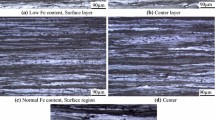Abstract
Pole figures have been constructed and textures have been compared for aluminum foils from various manufacturers in the as-delivered state and after additional annealings. Difference in the orientations of the basic texture components have been revealed in annealed foils. The main type of the transformation of a texture upon annealing is the development of a texture component {001}〈100〉 whose orientation differs fundamentally from the basic texture components observed in the foil prior to annealing. In another type of texture transformations, new texture components close to the basic orientations of the deformation texture are developed along with the {001}〈100〉 orientation. In the case of a third type of texture transformations, along with the orientation {001}〈100〉 which is formed upon recrystallization, the major part of the basic deformation-texture components are retained. The orientations of the basic texture components that are formed upon annealing belong to fields of allowed orientations of the basic texture components that were present in the foil before annealing. Apart from regions with a high pole density, regions with a moderate pole density have been found in the pole figures of annealed foils.
Similar content being viewed by others
References
G. Wasserman and J. Grewen, Texturen metallischer Werkstoffe (Springer, Berlin, 1962; Metallurgiya, Moscow, 1969).
H. Inoue, T. Yamasaki, G. Gottstein, et al., “Recrystallization Texture and r-Value of Rolled and T4-Treated Al-Mg-Si Alloy Sheets,” in Proceedings of the 14th International Conference on Textures of Materials ICOTOM-14, Leuven, 2005 Mater. Sci. Forum 495–497, 573–578 (2005).
C. S. T. Chang, A. S. C. Yeung, and B. J. Duggan, “Producing a Random Recrystallization Texture in 6111 Aluminium Alloy,” in Proceedings of the 14th International Conference on Textures of Materials ICOTOM-14, Leuven, 2005 Mater. Sci. Forum 495–497, 591–596 (2005).
A. Todayama and H. Inagaki, “Rolling and Recrystallization Textures in High Purity Al Cold Rolled to Very High Rolling Reductions,” in Proceedings of the 14th International Conference on Textures of Materials ICO-TOM-14, Leuven, 2005, Mater. Sci. Forum 495–497, 603–609 (2005).
D. I. Lainer and A. I. Radishevskii, “Construction of Pole Figures Using the Levels of Pole Density,” Zavod. Lab., No. 2, 183–186 (1970).
D. B. Titorov, “Prediction of Recrystallization Texture,” Fiz. Met. Metalloved. 36(1), 91–96 (1973).
D. B. Titorov and N. M. Knyazev, “Types of Texture Transformations upon Recrystallization,” Fiz. Met. Metalloved. 53(1), 116–123 (1982).
Author information
Authors and Affiliations
Additional information
Original Russian Text © D.B. Titorov, V.A. Volkov, V.P. Lebedev, F.V. Mineev, D.V. Titorova, 2006, published in Fizika Metallov i Metallovedenie, 2006, Vol. 102, No. 1, pp. 763–769.
Rights and permissions
About this article
Cite this article
Titorov, D.B., Volkov, V.A., Lebedev, V.P. et al. Texture transformations upon annealing of aluminum foils: I. Strong texture components. Phys. Metals Metallogr. 102, 83–89 (2006). https://doi.org/10.1134/S0031918X06070118
Received:
Issue Date:
DOI: https://doi.org/10.1134/S0031918X06070118




